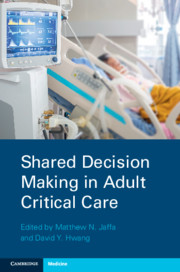Book contents
- Shared Decision Making in Adult Critical Care
- Shared Decision Making in Adult Critical Care
- Copyright page
- Dedication
- Contents
- Contributors
- Preface
- Chapter 1 When Does Shared Decision-Making Apply in Adult Critical Care?
- Chapter 2 How Much Does the Family Want to Be Involved in Decision-Making?
- Chapter 3 Show Me the Data
- Chapter 4 Communication Skills for Critical Care Family Meetings
- Chapter 5 The Do-Not-Resuscitate Order
- Chapter 6 The Do-Not-Intubate Order
- Chapter 7 Prolonged Ventilator Dependence for the Pulmonary Patient
- Chapter 8 Renal Replacement Therapy
- Chapter 9 Shared Decision-Making during Extracorporeal Membrane Oxygenation
- Chapter 10 Hypoxic–Ischemic Brain Injury after Cardiac Arrest
- Chapter 11 Decompressive Craniectomy for Stroke Patients
- Chapter 12 Decompressive Craniectomy for Traumatic Brain Injury Patients
- Chapter 13 Severe Traumatic Spinal Cord Injury
- Chapter 14 Potentially Inappropriate Treatment and Conscientious Objection
- Chapter 15 Shared Decision-Making in Emergent Situations
- Chapter 16 Advance Directives
- Chapter 17 Care of the Unbefriended Patient
- Chapter 18 The Role of Palliative Care in the Intensive Care Unit
- Chapter 19 Measuring and Evaluating Shared Decision-Making in the Intensive Care Unit
- Chapter 20 Brain Death Discussions
- Index
- References
Chapter 18 - The Role of Palliative Care in the Intensive Care Unit
Published online by Cambridge University Press: 27 May 2021
- Shared Decision Making in Adult Critical Care
- Shared Decision Making in Adult Critical Care
- Copyright page
- Dedication
- Contents
- Contributors
- Preface
- Chapter 1 When Does Shared Decision-Making Apply in Adult Critical Care?
- Chapter 2 How Much Does the Family Want to Be Involved in Decision-Making?
- Chapter 3 Show Me the Data
- Chapter 4 Communication Skills for Critical Care Family Meetings
- Chapter 5 The Do-Not-Resuscitate Order
- Chapter 6 The Do-Not-Intubate Order
- Chapter 7 Prolonged Ventilator Dependence for the Pulmonary Patient
- Chapter 8 Renal Replacement Therapy
- Chapter 9 Shared Decision-Making during Extracorporeal Membrane Oxygenation
- Chapter 10 Hypoxic–Ischemic Brain Injury after Cardiac Arrest
- Chapter 11 Decompressive Craniectomy for Stroke Patients
- Chapter 12 Decompressive Craniectomy for Traumatic Brain Injury Patients
- Chapter 13 Severe Traumatic Spinal Cord Injury
- Chapter 14 Potentially Inappropriate Treatment and Conscientious Objection
- Chapter 15 Shared Decision-Making in Emergent Situations
- Chapter 16 Advance Directives
- Chapter 17 Care of the Unbefriended Patient
- Chapter 18 The Role of Palliative Care in the Intensive Care Unit
- Chapter 19 Measuring and Evaluating Shared Decision-Making in the Intensive Care Unit
- Chapter 20 Brain Death Discussions
- Index
- References
Summary
Originating mostly in the world of oncology, palliative care has matured into a wide-ranging field aimed at improving the quality of life of all patients and their families facing the problems associated with life-threatening illnesses. Palliative care aims at preventing and relieving physical, social, psychological, and spiritual suffering. Components of palliative care vary based on the setting, but generally include (1) relationship and rapport building with patients and family members; (2) addressing and managing physical, social, psychological, and spiritual symptoms; (3) eliciting patient and family values; (4) interpreting and communicating information about the patient’s illness, prognosis, and treatment options and ensuring understanding; (5) helping patients and families to cope with life-altering circumstances and preventing or managing grief; (6) identifying and resolving conflicts, either between family members, between different medical team members, or between family and medical teams; (7) assisting with goal setting and advance care planning; and (8) hospice referral and discharge planning.1,2 Palliative care can be provided to patients and their families in any setting and at any time during the course of an illness, and may be offered alongside curative treatment.
- Type
- Chapter
- Information
- Shared Decision Making in Adult Critical Care , pp. 157 - 166Publisher: Cambridge University PressPrint publication year: 2021



